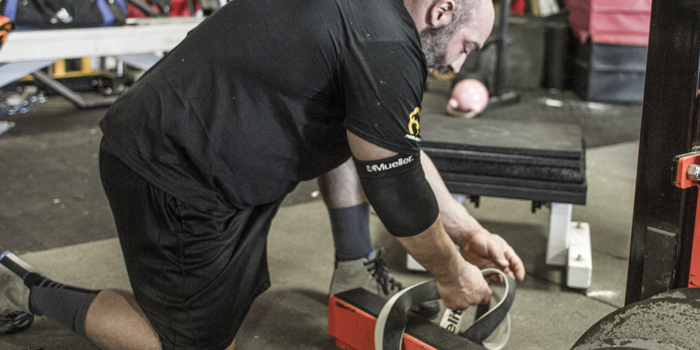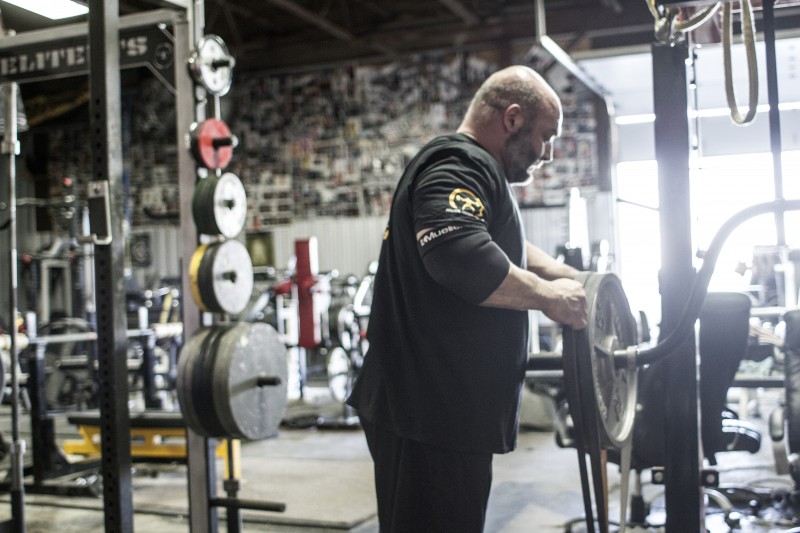
Velocity based training (VBT) and force-velocity profiling (FVP) are closely related. The FVP gives indications of strengths, weakness, and imbalances of an individual's physiological state based on their own force-velocity curve. There is a great deal of information regarding both areas, but I have found very little on how to use accommodating resistance in sync with not only VBT but also FVP. In the summer of 2017, I was able to perform some informal research on 10 Division II football athletes at East Stroudsburg University, looking at how to reverse imbalances found in their FVP by using VBT with a Tendo Unit and accommodating resistance by manipulating specific band tension ratios.
Stretch bands are an incredible way to develop power in the barbell lifts. They increase eccentric speed (over-speed eccentrics) to create a faster stretch of the musculo-tendinous units during the lowering phase to allow for greater storage and release of energy during the concentric phase of the lift. When bands—or chains even—are applied to a bar, they actually mimic the human body’s changes in mechanical advantages through the range of motion of the specific movement.
LISTEN: Developing Athletes Through the APRE Protocol for Strength Training
In the squat, the body is in its strongest position standing straight up (where the moment arm matches the resistance arm), which is also where the band tension is highest. As the lifter lowers to the bottom of the squat, they reach their weakest position (where the resistance arm is acting at the farthest point away from the moment arm and axis of rotation) and the band tension mimics this, as the bands are weakest at the bottom. Lastly, the bands help to reduce bar deceleration.
With light to moderate loads and no accommodating resistance, one cannot truly accelerate through a movement because, if they did, the bar would go flying off their back and turn the exercise into a form of ballistics. Therefore, there is a short phase where the body actually slows itself down prior to the completion of the range of motion to prevent losing contact with the bar. Bands essentially make the lifter accelerate through a load completely, as the bands will always hold the bar down. Increasing eccentric speed, mimicking of the human body’s biomechanical advantages, and reduction of bar deceleration are three benefits that one gets from training with bands.
The information laid out above is very well known, as Louie Simmons preaches this constantly in his books and articles. What is not emphasized as much in his work are the specific adaptations developed that vary with band weight to straight weight ratios. Dr. Bryan Mann briefly outlines guidelines for band to straight weight ratios that develop specific strengths in his book Developing Explosive Athletes: Use of Velocity Based Training in Training Athletes, as does Max Schmarzo and Matt Van Dyke in their book Applied Principles of Optimal Power Development. The chart at the bottom of the article is a brief overview of both party's works that relate to this subject.
The greater the band contribution to a lift, the higher the velocity will be at the same relative load compared to a lower band contribution. "Relative load" is a term that I use to help describe the force versus velocity differences that can be found during dynamic effort (DE) lifts with various band tensions applied. I found (only in a small study with a small sample size) that specific relative loads of 1RM showed trends of certain speeds with both force DE lifts (band to straight weight ratio of 25% to 75%) and velocity DE lifts (band to straight weight ratio of 50% to 50%). FVP was measured using force plates for this study. This is not very practical or applicable to most coaches and trainers that have personal gyms. A very suitable substitution would be to use a contact mat. Jump height can be used to determine FVP using the free FVP calculator that Max Schmarzo of Strong By Science developed in 2017, which can be found on his website.
It is important to note that these ratios were not perfect. Band tension is difficult to measure exactly, as it is dependent on the band itself (state and prior usage), as well as the length at which it is stretched. So, for each subject, during each session, I needed to calculate the relative load of 1RM, the percentage of band and straight weight, and which band would yield the closest range.
After all this information, I know you are still wondering how this relates to the FVP and sport athletes. These calculations and explanations above were used to make a progression of DE sessions at specific relative loads with either a force or velocity ratio. For sport athletes, squats to a box at approximately three-quarters depth with a touch and go (not a full-sit powerlifting style) were used to develop strength in the range of motion that the majority of explosive sporting movements occur in. The following are basic guidelines to progress from imbalanced to balanced FVP, either force or velocity deficient:
Velocity Deficient Athletes
Velocity deficient athletes need to work at higher band tensions (at or above 50%) to help their body recognize faster speeds with weight. Using VBT with a relative load progression of 80%, 85%, 90%, 95%, and 100% of 1RM with a 50-50 split in band to straight weight on the bar will produce great improvements in bar speed and FVP in just five weeks. The strength quality trained will range from explosive strength to speed strength, as seen by the velocities produced using a Tendo Unit. Desired velocity is 1.13 meters per second to 0.9 meters per second throughout the progression. The key is maximal intent to move the bar as fast as possible on every single rep. Without this, there will be no transfer.
Velocity deficient athletes need to continue to work on higher intensities of strength as well. On the “heavier” days, a five-week protocol prescribing high-intensity work to be between 0.7 meters per second and 0.75 meters per second will yield benefits in speed strength and can translate to increased absolute strength as well.
Force Deficient Athletes
Force deficient athletes need to get stronger, as they usually lack absolute strength. The contribution to improved FVP is more unknown regarding DE ability. The key is that the athletes in the study all improved on their absolute strength. These athletes need to develop high forces as well as learn to produce them at higher speeds to continue to produce power. That is why there is a lower band contribution and the special strength trained is strength-speed (between 0.89 and 0.7 meters per second). Using VBT with a relative load progression of 65%, 70%, 75%, 80%, and 85% of max with a 25% to 75% split in band to straight weight on the bar will produce improvements in strength-speed.
I hope that this article can give any coaches and trainers who are interested in this area some direction on how to fix imbalances in the FVP. Louie Simmons’s DE method with accommodating resistance is a great way to train an athlete’s weak point along their own force-velocity curve. If one has the means to accomplish this, by all means, give it a shot. All that is needed is a pre- and post-FVP test with countermovement jumps. If one wants to learn more about the force-velocity profile, how to test it, what it means, etc., the research of J.B. Morin and others can provide that information.
*Velocity Deficient Training Zones, **Force Deficient Training Zones
References
- Dyke, M. S. (2017). Applied Principles of Optimal Power Development.
- Mann, D. B. (2016). DEVELOPING EXPLOSIVE ATHLETES: USE OF VELOCITY BASED TRAINING IN TRAINING ATHLETES (3rd ed.).
- Simmons, L. (2015). Special Strengths for All Sports. Flexibound.
Marc Gaudet is in the final process of becoming a graduate student at East Stroudsburg University of Pennsylvania for a Masters of Exercise Science. He completed two internships during undergraduate studies at ESU: the first with Brian’s One2One Fitness in Concord, New Hampshire, and the second under Cameron Josse, Sports Performance Director at Joe DeFranco’s Gyms in East Rutherford, New Jersey. Guadet is developing a thesis in which neuromuscular fatigue cycles will be assessed in Division II football players during weekly periods to determine the usefulness of readiness testing for weekly peaking during times of competition. He can be reached at Marcgaudet42@gmail.com.












Could you do a velocity day and a force day each once a week?
Or maybe just put the two after one another so you would have your DE days for the next 10 weeks?